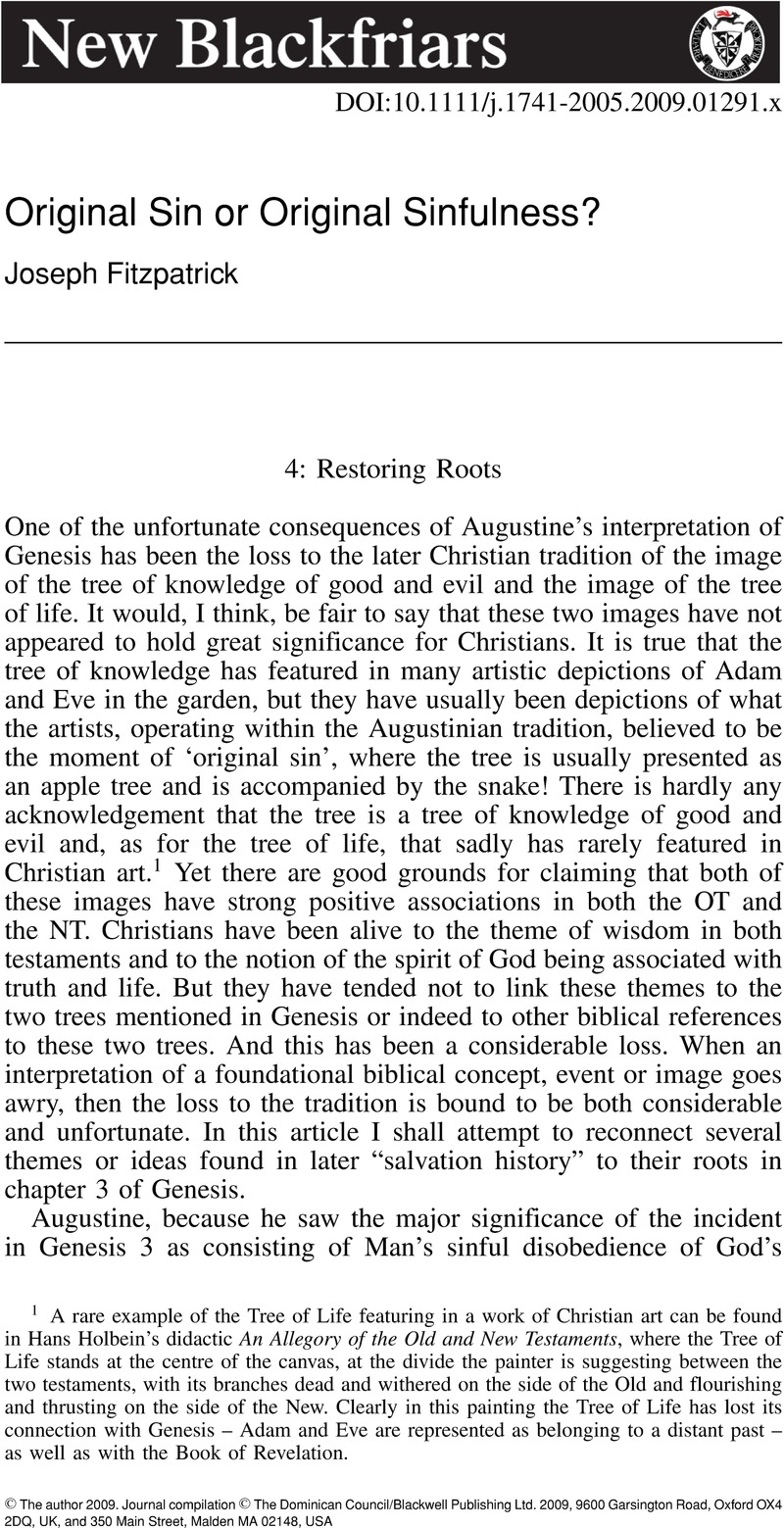No CrossRef data available.
Published online by Cambridge University Press: 01 January 2024

1 A rare example of the Tree of Life featuring in a work of Christian art can be found in Hans Holbein's didactic An Allegory of the Old and New Testaments, where the Tree of Life stands at the centre of the canvas, at the divide the painter is suggesting between the two testaments, with its branches dead and withered on the side of the Old and flourishing and thrusting on the side of the New. Clearly in this painting the Tree of Life has lost its connection with Genesis – Adam and Eve are represented as belonging to a distant past – as well as with the Book of Revelation.
2 This view is cited with approval by Shuster, Marguerite, The Fall and Sin (Eardmans Grand Rapids 2004), 50–51Google Scholar.
3 Viviano, Pauline A., “Genesis” in The Collegeville Bible Commentary, Old Testament (The Liturgical Press 1988), 44Google Scholar.
4 See, for example, McCarter, P. Kyle, in The Anchor Bible (Doubleday and Co 1984), 422 note 36Google Scholar.
5 My understanding of Ecclesiastes is indebted to an unpublished Ph.D. thesis by Rev. Kieran Heskin entitled Qoheleth's Concept of God (the University of Leeds, Department of Theology and Religious Studies 1985).
6 This is perhaps the best response to the divide between old and new suggested by Holbein's distinctively Lutheran interpretation of the divide separating the Old, the realm of the Law, and the New, the realm of grace. See above note 1. The Sophia-Logos link suggests continuity and development rather than division.
7 For example, Acts of the Apostles 5:30; 10: 39; Galatians 3:13; 1 Peter 2: 24
8 St Augustine, Ad Simplicianum de diversis questionibus, written in AD 396; Vol VI of “The Library of Christian Classics”, translated with introduction by JHS Burleigh (SCM Press 1953).
9 St Augustine, , De natura et gratia, written in AD 414; Vol 86 (Catholic University Press of America 1992)Google Scholar, translated by JA Mourant and WJ Collinge.
10 It is true that the Jerusalem Bible English translation of 1966 speaks of Adam's “fall” in verses 15–17, but this is a rather free translation of the Greek word paraptoma which most other English translations render as “misdeed” or “wrongdoing” or “fault” or “trespass” and which the Latin Vulgate translates as “delictum”.
11 The point is well made by Brunner, Emil in The Divine Imperative (Lutterworth Press 1937Google Scholar), in Book I, chapter 9, “The Definition of the Christian Ethic”.
12 Balthasar, Hans Urs von, Word and Redemption: Essays in Theology 2 (Herder and Herder 1964), 153, footnote 1Google Scholar.
13 The links with Genesis in this passage are clear enough, but it is worth noting that the more proximate template for this passage is Ezekiel 47:1–12, where the emphasis is once again on the water of life nourishing the trees growing on either side of it, whose leaves will be for healing. St John alludes to this passage in Ezekiel when he speaks of the water issuing from the wound in the side of the crucified Christ. (Jn 19: 34)
14 See Barr, James, The Garden of Eden and the Hope of Immortality (SCM Press 1992), 116Google Scholar.
15 Wright, Tom, The Lord and his Prayer (SPCK 1996), 24Google Scholar.